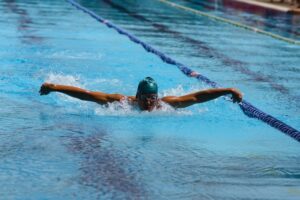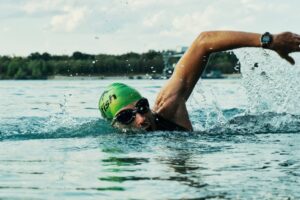Swimming the butterfly stroke is both a challenging and rewarding endeavor. Its distinctive undulating motion and powerful kicks set it apart, making it a stroke that demands precision and technique. Whether you’re a beginner or looking to refine your skills, this step-by-step guide will provide you with the insights and instructions needed to swim the butterfly stroke with confidence and efficiency.
The Basics of Butterfly Stroke
Before diving into the specifics, it’s essential to understand the fundamental components of the butterfly stroke.
1. Body Positioning
Maintain a horizontal position in the water, keeping your body straight and parallel to the surface. This helps reduce drag and allows for a more streamlined movement.

2. Dolphin Kick
The butterfly’s signature move, the dolphin kick, involves a rhythmic and undulating motion of the legs. Keep your legs close together, and initiate the kick from your hips, not your knees. Practice the dolphin kick to build strength and flexibility in your lower body.
Perfecting the Dolphin Kick
3. Undulating Motion
Practice the undulating motion of the dolphin kick by focusing on the downward and upward kicks. The downward kick generates propulsion, while the upward kick reduces resistance. Combine these movements to create a continuous, fluid motion.
4. Leg Strength
Building leg strength is crucial for an effective dolphin kick. Incorporate leg exercises such as flutter kicks and dolphin kick drills to enhance the power and endurance of your legs.
Coordination is Key
5. Arm Movements
Coordinate your arm movements with the dolphin kick for a harmonious stroke. As your legs kick downward, your arms should perform a powerful pull, moving simultaneously to create forward momentum.

6. Recovery Phase
After the pull, initiate the recovery phase by lifting your arms out of the water. Keep your elbows slightly bent, and bring your arms forward over the water’s surface. This phase allows for a quick breath and sets you up for the next powerful pull.
Breathing Techniques
7. Timing is Crucial
Proper timing is essential for effective breathing in butterfly stroke. Breathe in quickly during the recovery phase, lifting your head above the water. Exhale as your head returns to the water during the arm pull. Practice rhythmic breathing to maintain a steady and efficient pace.
8. Minimize Head Movement
Keep head movement to a minimum to reduce drag and maintain a streamlined position. A quick and controlled lift for breathing helps optimize oxygen intake without sacrificing speed.
Building Strength and Endurance
9. Core Strength
Developing a strong core is integral to mastering the butterfly stroke. Engage your core muscles throughout the stroke to enhance stability and control. Incorporate exercises like planks and leg raises into your training routine.
10. Endurance Training
To excel in the butterfly, focus on building overall endurance. Include swim sets that gradually increase in distance, allowing your body to adapt to the demands of the stroke. Consistent training will improve your stamina and performance over time.
Drills for Improvement:
11. Dolphin Kick Drill:
Isolate the dolphin kick by using a kickboard. Hold the board with your arms extended and perform the dolphin kick, focusing on the undulating motion. This drill helps refine the kick’s technique and strengthens the leg muscles.

12. Arm Pull Drill:
Use a pull buoy to isolate the arm movements. Focus solely on the pull phase of the stroke, emphasizing a powerful and efficient movement. This drill enhances arm strength and coordination.
Common Mistakes to Avoid:
13. Overextending Arm Movements:
Avoid overextending your arms during the pull phase. Keep the movements within your natural range to maintain efficiency and reduce the risk of fatigue.
14. Neglecting Core Engagement:
A weak core can lead to poor body positioning and reduced stroke efficiency. Prioritize core exercises to ensure stability and control throughout the butterfly stroke.
Video Analysis for Feedback
15. Record and Review
Take advantage of modern technology by recording your butterfly stroke. Review the footage to identify areas for improvement, focusing on body positioning, kick technique, and arm movements. Seek feedback from coaches or experienced swimmers to refine your technique further.
Putting It All Together:
16. Practice Regularly
Consistency is key when mastering the butterfly stroke. Dedicate regular practice sessions to refine each element of the stroke. Set achievable goals and celebrate small victories along the way.
17. Gradual Progression
Progress at your own pace and gradually increase the intensity and duration of your butterfly swim sessions. Building a strong foundation and gradually challenging yourself will lead to sustainable improvement.
Conclusion
In conclusion, swimming the butterfly stroke is an art that requires a combination of strength, coordination, and technique. By following these step-by-step instructions and incorporating targeted drills into your training routine, you’ll be well on your way to mastering the butterfly stroke. Embrace the challenge, stay persistent, and enjoy the exhilaration of gliding through the water with the grace of a butterfly. Happy swimming!
AUTHOR
Sang Nguyen
Sang Nguyen is a former national swimmer for Vietnam who has transitioned into coaching. With a passion for fostering a healthy swimming community and connecting like-minded individuals,......Read More
BLOG
Maybe You Are Interested
Butterfly Arm Stroke Movement
The butterfly stroke, with its captivating undulations and powerful movements, requires a refined butterfly arm...
2 Butterfly Kick Swimming Drills: Building Power from the Core
The butterfly stroke, known for its powerful undulations and graceful movements, relies heavily on a...
5 Ways to Improve Your Butterfly Swim Technique
The butterfly stroke, also known as the fly swimming technique, is a captivating display of...
8 Butterfly Stroke Tips to Help You Improve Your Skill
The butterfly stroke, also known as the butterfly swim, is undeniably one of the most...
Discover Information About Butterfly Stroke: From History to Technique and Benefits
The butterfly stroke, also known as butterfly swim or fly swim stroke, is one of...
Competitive Swimmer Diet in Olympics: Fueling Your Gold Medal Dreams
Competitive swimmers push their bodies to the limit, demanding a competitive swimmer diet that provides...